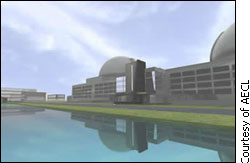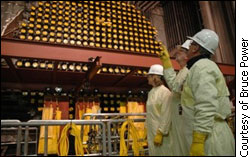
|
|
Society’s view that nuclear power offers toxic waste and dangerous meltdowns has kept research from expanding, says Ron Oberth, Atomic Energy Canada Limited’s marketing coordinator whose background is in engineering and physics. Renaissance reactor The new Advanced Candu Reactor currently being developed by AECL, however, far surpasses Mr. Burns’ archaic plant. Its blueprint is a signal that a nuclear renaissance is approaching, says Oberth. “There have been no new plants approved since 1977 because there was concern about nuclear safety and performance in the U.S.,” he says. “But now, fossil fuels are depleting and a nuclear renaissance must play a role if we want to survive as a planet.”
Currently 51 per cent of Ontario’s power is supplied by nuclear energy. This rebirth will potentially generate more “clean” energy and more questions about environmental issues such as storage of radioactive waste. The ACR-1000’s experimental model has only been tested in modules because of a $5 billion price tag. It is a hybrid design of the older Candu model combined with technology from light water reactors, says Oberth. The ACR-1000’s technology will differ from the traditional Candu reactors in two main ways. “We’re changing fuel from natural to slightly enriched uranium and using light water in the cooling system,” Oberth says. By moving to slightly enriched uranium—a process where the percentage of U-235 will be increased by about 2.5 per cent—the reactor can work at a higher pressure and temperature for three times longer, improving efficiency and creating more energy, says Oberth. Since the 1960s, when the original Candu reactors were developed, AECL has used heavy water pressurized reactors, says Oberth. Heavy water acts a moderator to slow down the neutrons allowing for continuous fission. It is identical to light, or regular, water except that the two hydrogen atoms each have an extra neutron, making it “neutron-heavy”. This is an advantage because it allows the use of cheaper natural uranium.
Currently, the ACR-1000 can only be viewed on a computer screen or in pieces at the Chalk River Laboratories. Until someone buys one, these experiments won’t be converted into reality. Alberta Energy Corporation and Bruce Power may build two ACR-1000's in Northern Alberta, but it isn’t certain says Rob Liddle, a communication consultant at Bruce Power. Dr. Gordon Edwards, an expert on nuclear energy and President of the Canadian Coalition for Nuclear Responsibility, says he’s concerned that this reactor may be used in Alberta even though it is only an “experimental design.” Sustainable source Other scientists support the use of nuclear power, seeing it as a sustaianable energy option. Along with 65 other professors, Dr. Jatin Nathwani, the Ontario Research Chair in Public Policy for Sustainable Energy Management, is examining the environmental performance of different energy options at the Waterloo Institute for Sustainable Energy. Even compared to clean sources of power, such as wind and natural gas, nuclear power has a small environmental footprint because it is a high-density energy source, says Nathwani.
There is a spectacular difference in the energy these sources generate he says, pointing out that one kilogram of uranium creates 400,000 kilowatts (KWh) per hour of energy compared to three KWh from the same amount of coal. Nuclear power also has lower greenhouse gas emissions than other sources, says Nathwani. Alberta Energy has decided to build two reactors on the northern prairies. It would save emissions of 3.3 million tonnes of carbon dioxide each year produced while extracting oil from the tar sands, estimates the Uranium Information Centre in Australia. “The whole question of climate change is an issue it wasn’t 12 years ago,” Nathwani says. “People realize it isn’t going away.” Waste away Another problem that isn’t going anywhere is spent fuel waste. One of the greatest challenges facing nuclear energy production is the creation of radioactive waste, says Edwards. “The fission products are so hot and radioactive, a single spent bundle would kill a human being in 20 seconds” from a metre away, he said at the lecture in Edmonton. Dr. David Shoesmith, the NSERC Research Chair in Nuclear Fuel Disposal says modern storgage is safe but if there is going to be a new nuclear renaissance, long-term storage is a must. Since 1978, Canada has debated on a permanent solution for nuclear waste. The most supported idea is to store it in a deep geologic repository. Shoesmith conducts scientific studies on how waste will react underground. His research shows that a cooper container should be used since the metal is stable underground in an oxygen-deprived environment.
“We are designing a system with multiple barriers that won’t fail the same way all at once,” says Shoesmith. “We statistically calculated that we’ll need five or six barriers.” In the near future, there is no reason to permanently get rid of the fuel, says Shoesmith. If construction began tomorrow, it would still be 20 or 30 years before the repository was ready. “It is better to wait and see what happens to the industry,” he says. “We need to take a good scientific look at how we might recycle this energy.” Even if the ACR-1000 is bought soon, it wouldn't be operating until 2017. Meanwhile, research in the nuclear science field has begun to quickly progress, trying to keep up with North America’s guzzling desire for energy and hopefully, says Oberth, leaving behind its negative neon image.
|
|
|

